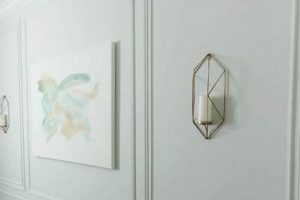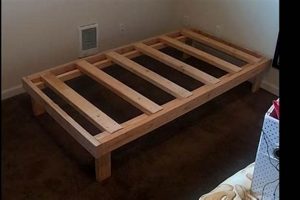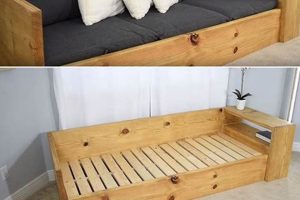A self-constructed sleeping platform, typically made from lumber, constitutes an alternative to commercially manufactured bed frames. These projects range from rudimentary platforms designed for minimalist aesthetics to elaborate constructions incorporating headboards, footboards, and storage solutions. Materials often include pine, oak, or reclaimed wood, reflecting individual preferences and budget considerations. For example, a basic platform might involve assembling four side rails and several slats, while a more complex design could necessitate joinery techniques and advanced woodworking skills.
The appeal of creating a bed frame lies in the opportunity for customization, cost savings, and personal satisfaction. Individuals can tailor the dimensions and design to perfectly suit their mattress size and room layout, circumventing the limitations of standardized furniture offerings. Furthermore, constructing it oneself often proves more economical than purchasing a comparable item from a retailer. The historical precedent for handcrafted beds is rooted in self-sufficiency and resourcefulness, particularly in periods and regions where manufactured goods were scarce or expensive.
Understanding the structural elements, selecting appropriate materials, and employing proper construction techniques are paramount to the successful execution of such a project. Subsequent sections will delve into detailed design considerations, material sourcing strategies, essential tools, and step-by-step assembly instructions to facilitate the creation of a durable and aesthetically pleasing sleeping platform.
Essential Considerations for Constructing a Wood Sleeping Platform
The following tips address key factors to consider when embarking on a project to build a wood sleeping platform, ensuring structural integrity and longevity.
Tip 1: Material Selection is Paramount: Opt for kiln-dried hardwood or softwood to minimize warping and cracking. Consider the wood’s density and grain pattern to ensure it can withstand the weight of the mattress and occupants. Pine is a cost-effective option, while oak or maple offer superior durability.
Tip 2: Accurate Measurements are Critical: Precisely measure the mattress dimensions and add necessary clearance for bedding. Inaccurate measurements can result in a frame that is too small or too large, compromising comfort and stability.
Tip 3: Prioritize Structural Integrity: Utilize robust joinery techniques such as mortise and tenon, dovetail joints, or pocket hole screws reinforced with wood glue to ensure frame stability. Weak joints are prone to failure under load.
Tip 4: Proper Support System is Essential: Ensure adequate slat spacing to prevent mattress sagging. Slats should be evenly distributed and securely attached to the frame. Consider adding a center support beam for larger mattresses to prevent bowing.
Tip 5: Finishing Protects the Wood: Apply a sealant, stain, or paint to protect the wood from moisture and wear. This also enhances the aesthetic appeal of the structure. Select a non-toxic finish, particularly for individuals with sensitivities.
Tip 6: Hardware Selection Matters: Utilize high-quality screws and bolts designed for wood construction. Avoid using nails alone, as they lack the holding power required for a bed frame. Ensure all hardware is countersunk to prevent snagging on bedding.
These considerations will contribute to the creation of a safe, sturdy, and aesthetically pleasing wood sleeping platform, providing years of reliable use.
With these principles in mind, the following sections will elaborate on specific construction methods and design options for a personalized sleeping space.
1. Design Customization
Design Customization, in the context of a self-constructed wood sleeping platform, represents the ability to tailor the dimensions, style, and features of the bed frame to meet individual requirements and aesthetic preferences. This flexibility distinguishes a self-built structure from mass-produced alternatives, offering opportunities for unique and personalized sleeping solutions.
- Dimensional Tailoring
Dimensional Tailoring refers to the ability to modify the frame’s length, width, and height to precisely accommodate the mattress and fit the room’s spatial constraints. This is especially pertinent in rooms with unusual layouts or limited square footage, where standard-sized frames may prove unsuitable. For instance, a loft apartment might necessitate a shorter frame, while a larger bedroom could accommodate a wider or longer design. The ability to adjust these dimensions ensures optimal space utilization and ergonomic comfort.
- Aesthetic Adaptation
Aesthetic Adaptation involves modifying the design to align with the desired visual style. This can encompass the incorporation of specific wood types, finishes, headboard designs, and decorative elements. Examples include a rustic frame constructed from reclaimed wood, a modern minimalist platform with clean lines, or a traditional frame with ornate carvings. The freedom to select materials and finishes enables the creation of a frame that complements the overall room dcor and reflects personal taste.
- Functional Integration
Functional Integration refers to the incorporation of additional features, such as built-in storage compartments, integrated lighting, or adjustable headboards. Under-bed storage drawers maximize space in smaller rooms, while integrated reading lights provide convenience and ambiance. The addition of a tilting headboard offers enhanced comfort for reading or watching television in bed. These functional enhancements transform the sleeping platform into a more versatile and personalized space.
- Ergonomic Considerations
Ergonomic Considerations entail adjusting the frame’s height and features to promote optimal comfort and accessibility. A lower frame facilitates easy access for individuals with mobility limitations, while a higher frame can simplify bed-making. The addition of a sloped headboard provides lumbar support for reading or lounging. Attending to these ergonomic details enhances the user experience and contributes to overall well-being.
These facets of design customization underscore the unique advantages of building a sleeping platform. By tailoring the dimensions, style, features, and ergonomics, it is possible to create a sleeping structure that perfectly aligns with individual needs and preferences, transforming the bedroom into a truly personalized and functional space. Further examples include incorporating charging stations directly into the frame or designing a platform that accommodates specific medical equipment. The possibilities are limited only by imagination and skill.
2. Material Durability
Material durability is a paramount consideration in the construction of any long-lasting structure, and it holds particular significance when applied to a wood sleeping platform. The selection of appropriate materials directly impacts the bed frame’s ability to withstand sustained weight, resist wear and tear, and maintain structural integrity over time. Inadequate material selection can lead to premature failure, compromising both safety and comfort.
- Wood Species Selection
The choice of wood species is fundamental to the durability of the sleeping platform. Hardwoods, such as oak, maple, and cherry, exhibit superior density and resistance to denting and scratching compared to softwoods like pine or fir. While softwoods may be more cost-effective and easier to work with, their lower density makes them more susceptible to damage from impacts and prolonged stress. The selection should balance cost constraints with the anticipated level of use and potential for wear.
- Material Thickness and Dimensions
The thickness and dimensions of the lumber used in the frame’s construction directly influence its load-bearing capacity. Thicker side rails, headboards, and footboards provide greater resistance to bending and deformation under the weight of the mattress and occupants. Similarly, the dimensions of the support slats determine their ability to distribute weight evenly and prevent sagging. Insufficient material thickness can result in structural weakness and potential collapse.
- Moisture Content and Kiln Drying
The moisture content of the wood significantly impacts its stability and susceptibility to warping and cracking. Lumber with high moisture content is prone to shrinkage and distortion as it dries, compromising the structural integrity of the frame. Kiln-dried lumber, which has been carefully dried to a low moisture content, minimizes these risks and ensures greater dimensional stability over time. Proper drying techniques are essential for maximizing the long-term durability of the wood.
- Protective Finishes and Coatings
The application of protective finishes and coatings, such as sealants, varnishes, or paints, enhances the wood’s resistance to moisture, scratches, and UV damage. These finishes create a barrier that prevents water penetration, reducing the risk of rot and decay. They also provide a protective layer against surface abrasion, preserving the aesthetic appearance of the frame. Selecting durable and appropriate finishes is crucial for extending the lifespan of the structure and maintaining its structural integrity.
The durability of a wood sleeping platform is intrinsically linked to the careful selection and treatment of its constituent materials. By prioritizing high-quality lumber, appropriate dimensions, proper drying techniques, and protective finishes, it is possible to construct a frame that provides years of reliable support and withstands the rigors of daily use. The longevity of the structure is a direct reflection of the investment in material quality and thoughtful construction practices.
3. Joint Strength
Joint strength is a critical factor in the structural integrity of any wood sleeping platform. The joints, where individual pieces of wood are connected, are often the weakest points in the frame. The ability of these joints to withstand the forces exerted by the mattress and occupants determines the bed’s stability, durability, and overall safety. Selecting appropriate joint types and employing proper construction techniques are paramount to ensuring long-term performance.
- Mortise and Tenon Joints
Mortise and tenon joints, consisting of a projecting tenon that fits snugly into a mortise (hole), are renowned for their strength and stability. This type of joint provides a large surface area for glue adhesion and mechanical interlocking, resulting in a robust connection capable of withstanding significant shear and tensile forces. Examples include connecting bed posts to side rails and creating a solid headboard frame. Failure to execute this joint correctly can lead to racking and eventual joint separation.
- Dovetail Joints
Dovetail joints, characterized by interlocking wedge-shaped projections, offer exceptional resistance to pulling forces. These joints are particularly well-suited for connecting drawer fronts to sides or securing corners of a bed frame. The interlocking design provides a mechanical advantage, preventing the joint from separating even under significant stress. Improperly fitted dovetails compromise the joint’s integrity and reduce its load-bearing capacity.
- Pocket Hole Joints
Pocket hole joints, created by drilling angled holes and securing them with screws, provide a relatively quick and easy method of joining wood. While not as inherently strong as mortise and tenon or dovetail joints, they can be effective when reinforced with wood glue and used in conjunction with properly sized screws. These joints are often used for attaching bed frame supports or constructing less critical structural elements. Over-tightening screws or using inadequate screw length can weaken the joint.
- Lap Joints
Lap joints involve overlapping two pieces of wood and securing them with fasteners and glue. These joints are relatively simple to construct and can provide adequate strength for certain applications, such as connecting bed frame side rails. However, lap joints lack the mechanical interlocking of mortise and tenon or dovetail joints, making them more reliant on glue adhesion. Insufficient glue or inadequate clamping pressure during assembly can lead to joint failure.
The selection and execution of appropriate joint types directly impact the longevity and safety of a wood sleeping platform. Strong, well-constructed joints ensure that the bed frame can withstand the stresses of daily use and provide a stable and reliable sleeping surface. Investing time and effort in mastering proper joinery techniques is essential for achieving a high-quality, durable, and safe final product.
4. Slat Support
Slat support forms an integral component of a self-constructed wood sleeping platform, directly influencing mattress performance, occupant comfort, and the overall longevity of the bed frame. The primary function of slats is to provide a level and adequately firm surface upon which the mattress rests, distributing weight evenly and preventing sagging. Inadequate or improperly spaced slats can lead to premature mattress wear, discomfort, and, in extreme cases, structural failure of the bed frame itself. For example, a full-size mattress placed on a frame with only three widely spaced slats will likely exhibit noticeable sagging in the center within a relatively short period, compromising both sleep quality and mattress lifespan.
The selection of slat material, spacing, and attachment methods are critical design considerations. Hardwood slats, such as poplar or maple, offer superior strength and resistance to bending compared to softwood alternatives. Closer slat spacing provides more uniform weight distribution and reduces the likelihood of mattress deformation. Secure attachment of the slats to the frame, using screws or specialized slat holders, prevents slippage and ensures long-term stability. A practical example involves comparing two frames: one with softwood slats spaced 6 inches apart, attached with staples, and another with hardwood slats spaced 3 inches apart, attached with screws. The latter construction will demonstrably provide better support and durability.
Understanding the principles of slat support is essential for anyone undertaking the construction of a wood sleeping platform. While seemingly a simple element, its proper implementation directly impacts the functionality, comfort, and lifespan of the bed. Challenges in slat support often stem from cost-cutting measures or a lack of understanding of structural mechanics. However, prioritizing robust materials, appropriate spacing, and secure attachment methods will ultimately result in a more durable and comfortable sleeping environment, aligning with the broader goals of self-sufficiency and personalized design inherent in the creation of a wood sleeping platform.
5. Finishing Quality
Finishing quality significantly impacts the longevity, aesthetics, and safety of a self-constructed wood sleeping platform. It encompasses the processes applied to the wood surface after construction, including sanding, staining, sealing, and painting. The choice of finishing materials and the thoroughness of application directly affect the wood’s resistance to moisture, scratches, and ultraviolet (UV) radiation. For example, a frame left unfinished is vulnerable to moisture absorption, leading to warping, cracking, and potential fungal growth. Conversely, a properly sealed and finished frame resists these environmental factors, extending its lifespan and maintaining its structural integrity.
A well-executed finish enhances the aesthetic appeal of the wood sleeping platform, complementing the design and style of the bedroom. Staining allows the wood’s natural grain to be accentuated, while painting provides an opportunity to introduce color and create a specific mood. Furthermore, a smooth, even finish eliminates sharp edges and splinters, improving safety and preventing snagging of bedding. Consider two scenarios: one where the frame is haphazardly painted, resulting in drips and an uneven surface, and another where the frame is meticulously sanded, stained with a high-quality product, and sealed with a durable topcoat. The latter exemplifies the impact of finishing quality on both appearance and tactile experience.
In summary, finishing quality is not merely a cosmetic consideration but an integral aspect of crafting a durable and aesthetically pleasing wood sleeping platform. It contributes to the bed’s structural integrity, protects the wood from environmental damage, and enhances its visual appeal. Challenges in achieving a high-quality finish often arise from inadequate surface preparation or the use of unsuitable materials. However, by prioritizing proper sanding techniques, selecting appropriate finishes, and applying them carefully, a builder can ensure a lasting and visually appealing result, solidifying the value and functionality of the constructed sleeping platform.
Frequently Asked Questions
The following addresses common inquiries regarding the design, materials, and construction of wood sleeping platforms. These answers are intended to provide clarity and guidance for prospective builders.
Question 1: What types of wood are most suitable for constructing a durable sleeping platform?
Hardwoods, such as oak, maple, and cherry, offer superior strength and resistance to wear compared to softwoods like pine or fir. While softwoods are more cost-effective, hardwoods are recommended for applications requiring long-term durability and load-bearing capacity.
Question 2: How critical is proper slat spacing for mattress support?
Adequate slat spacing is essential for preventing mattress sagging and ensuring proper weight distribution. Generally, slats should be spaced no more than 3-4 inches apart. Wider spacing can lead to premature mattress wear and discomfort.
Question 3: What joinery methods are recommended for ensuring frame stability?
Mortise and tenon joints, dovetail joints, and pocket hole joints (when reinforced with glue) are all viable options for constructing a stable bed frame. The choice of joint depends on the builder’s skill level and the desired aesthetic. However, all joints must be executed with precision to ensure structural integrity.
Question 4: Is kiln-dried lumber necessary for building a wood sleeping platform?
Kiln-dried lumber is highly recommended to minimize the risk of warping, cracking, and shrinkage. Lumber with high moisture content can distort over time, compromising the stability of the frame. Kiln-drying reduces moisture content to a stable level, ensuring long-term dimensional stability.
Question 5: What type of finish should be applied to protect the wood?
A durable sealant, varnish, or paint should be applied to protect the wood from moisture, scratches, and UV damage. The choice of finish depends on the desired aesthetic and the level of protection required. Ensure that the finish is non-toxic and properly cured before use.
Question 6: Are center support beams necessary for larger mattresses?
Center support beams are highly recommended for queen-size and king-size mattresses to prevent bowing and provide additional support. These beams distribute weight evenly and prevent the mattress from sagging in the middle. Omission of a center support beam can compromise the mattress’s lifespan and the comfort of the sleeping surface.
The above questions and answers provide a foundation for understanding the key considerations in building a wood sleeping platform. Careful planning and execution are crucial for achieving a durable and functional result.
The following section will address advanced design considerations and potential challenges.
DIY Wood Frame Bed
This exploration has elucidated the multifaceted nature of constructing a wood sleeping platform. From meticulous material selection and robust joint construction to optimized slat support and protective finishing, each element contributes to the overall durability, functionality, and aesthetic appeal of the structure. The implementation of sound design principles, coupled with adherence to established woodworking techniques, is paramount to achieving a safe and enduring sleeping solution.
The decision to undertake the creation of a bed frame represents a commitment to craftsmanship and personalized design. While challenges may arise during the construction process, a thorough understanding of the principles outlined herein will empower individuals to create a sleeping platform that reflects both their functional needs and aesthetic preferences. The long-term value of a well-executed project extends beyond mere cost savings, encompassing a tangible connection to the built environment and a durable asset for years to come.







